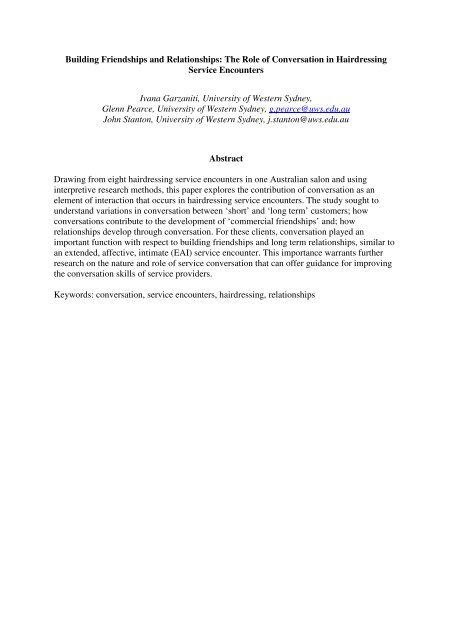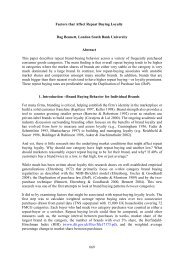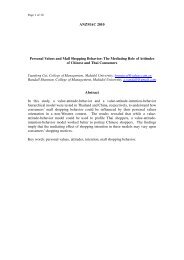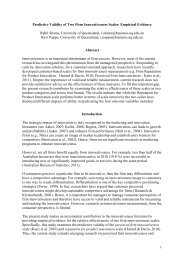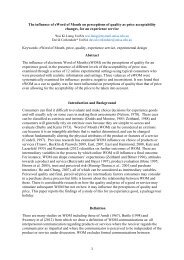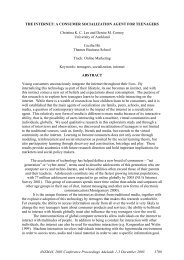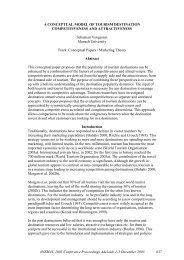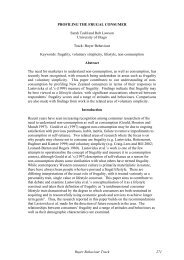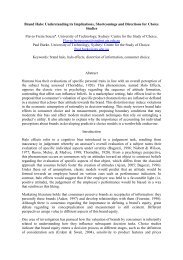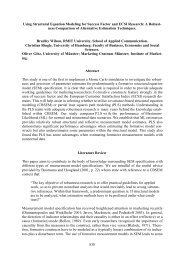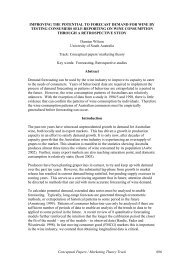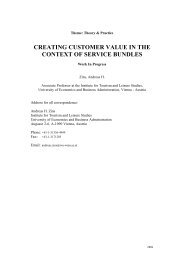Building Friendships and Relationships: The Role of ... - anzmac
Building Friendships and Relationships: The Role of ... - anzmac
Building Friendships and Relationships: The Role of ... - anzmac
You also want an ePaper? Increase the reach of your titles
YUMPU automatically turns print PDFs into web optimized ePapers that Google loves.
<strong>Building</strong> <strong>Friendships</strong> <strong>and</strong> <strong>Relationships</strong>: <strong>The</strong> <strong>Role</strong> <strong>of</strong> Conversation in Hairdressing<br />
Service Encounters<br />
Ivana Garzaniti, University <strong>of</strong> Western Sydney,<br />
Glenn Pearce, University <strong>of</strong> Western Sydney, g.pearce@uws.edu.au<br />
John Stanton, University <strong>of</strong> Western Sydney, j.stanton@uws.edu.au<br />
Abstract<br />
Drawing from eight hairdressing service encounters in one Australian salon <strong>and</strong> using<br />
interpretive research methods, this paper explores the contribution <strong>of</strong> conversation as an<br />
element <strong>of</strong> interaction that occurs in hairdressing service encounters. <strong>The</strong> study sought to<br />
underst<strong>and</strong> variations in conversation between ‘short’ <strong>and</strong> ‘long term’ customers; how<br />
conversations contribute to the development <strong>of</strong> ‘commercial friendships’ <strong>and</strong>; how<br />
relationships develop through conversation. For these clients, conversation played an<br />
important function with respect to building friendships <strong>and</strong> long term relationships, similar to<br />
an extended, affective, intimate (EAI) service encounter. This importance warrants further<br />
research on the nature <strong>and</strong> role <strong>of</strong> service conversation that can <strong>of</strong>fer guidance for improving<br />
the conversation skills <strong>of</strong> service providers.<br />
Keywords: conversation, service encounters, hairdressing, relationships
Background <strong>and</strong> Purpose<br />
<strong>The</strong> service encounter is both ‘social’ <strong>and</strong> ‘communicative’ (Sparks, 1994). <strong>The</strong> social nature<br />
<strong>of</strong>, <strong>and</strong> physical contact in the service encounter promotes intimacy (Goodwin & Frame,<br />
1989; Czepiel, 1990; Goodwin & Smith, 1990), which encourages friendly conversation<br />
between service employee <strong>and</strong> customer. <strong>The</strong> social nature <strong>of</strong> the service encounter can be<br />
attributed to the physical contact required, particularly in ‘people-processing’ services<br />
(Lovelock et al., 2007). Such services involve tangible actions directed at a person (‘high<br />
touch’), requiring the customer to be physically present during service delivery (Lovelock et<br />
al., 2007). ‘People processing’ is characterized by service customization, continuous<br />
relationships <strong>and</strong> high levels <strong>of</strong> customer contact (Lovelock, 1983). Moreover, given they are<br />
required to be physically present during the performance, there is significant involvement <strong>of</strong><br />
customers in the service process (Grönroos, 2000; Lovelock et al., 2007). Using a typology <strong>of</strong><br />
service encounters based on duration, affective content <strong>and</strong> spatial proximity, proposed by<br />
Price et al (1995), people processing service encounters are likely to fall into the extended,<br />
affective, intimate (EAI) category. Although Price et al., (1995) regard hairdressing as ‘low<br />
affect’, findings in this paper suggest it is actually ‘high affect’, dem<strong>and</strong>ing exchange<br />
qualities more likely to be associated with a friendship that engenders the building <strong>of</strong> a long<br />
term relationship.<br />
In this paper, the role <strong>and</strong> importance <strong>of</strong> conversation in eight hairdressing service encounters<br />
is examined from a customer perspective. Analysis <strong>of</strong> these conversations sought to<br />
underst<strong>and</strong>: variations in conversation between ‘short’ <strong>and</strong> ‘long term’ customers, how<br />
conversations contribute to ‘commercial friendships’ <strong>and</strong>; how relationships develop.<br />
Review: Conversation, Service Relationship <strong>and</strong> Friendship<br />
<strong>The</strong> definition <strong>of</strong> conversation used in this paper derives from a communications perspective:<br />
‘<strong>The</strong> continuing social process (Allen & Guy, 1974) where two socialized <strong>and</strong> co-present<br />
persons (Turnbull, 2003) engage in any interactive, spoken exchange with one another’<br />
(Pridham, 2004). Hairdressing is a ‘people-processing’ encounter where conversation is likely<br />
to play an important role. Solomon et al., (1985) state that hairdressing is characterized by a<br />
high degree <strong>of</strong> person-to-person interaction <strong>and</strong> the physical contact may create both intimacy<br />
<strong>and</strong> a closeness that decreases the perceived social distance between the service employee <strong>and</strong><br />
customer (Goodwin & Frame, 1989; Czepiel, 1990; Goodwin & Smith, 1990). This intimacy<br />
<strong>of</strong>ten encourages conversation between the service employee <strong>and</strong> customer. Butcher et al.,<br />
(2002) assert that the hairdresser is constantly within the customer’s personal space.<br />
Similarly, Price & Arnould (1999) argue that hairdressing “throws two people together for a<br />
relatively lengthy period <strong>of</strong> time… both parties are ‘held captive’ to the encounter” (p. 47). In<br />
such a situation, discussing conversation topics unrelated to the immediate service context can<br />
be a strategy for creating verbal ‘closeness’ or immediacy between the service employee <strong>and</strong><br />
customer (Ford, 1998).<br />
Services are inherently relational in nature (Grönroos, 2000). Czepiel (1990) emphasizes that<br />
relationships in services are important given “the social nature <strong>of</strong> service encounters, the<br />
active <strong>and</strong> <strong>of</strong>ten face-to-face interaction between service provider <strong>and</strong> client [<strong>and</strong>] the
difficulty <strong>of</strong> assessing service quality” (p. 17). Repeated encounters provide occasions for the<br />
development <strong>of</strong> a more complex <strong>and</strong> personal relationship (Czepiel, 1990). Bendapudi &<br />
Berry (1997) contend that customers make ‘investments’ <strong>of</strong> both time <strong>and</strong> effort in identifying<br />
service providers <strong>and</strong> developing relationships with them. In addition to reducing perceived<br />
risk, customers can reap social benefits from these relationships (Berry, 1995b).<br />
<strong>The</strong> development <strong>of</strong> a ‘friendship’ between service employee <strong>and</strong> customer has been explored<br />
by Goodwin (1996), Gwinner et al., (1998) <strong>and</strong> Price & Arnould (1999). Czepiel (1990, p.16)<br />
argues that since “service encounters are social encounters first, it is only natural that repeated<br />
encounters develop personal as well as pr<strong>of</strong>essional dimensions”. Bitner (1994) claims the<br />
relationship between the service employee <strong>and</strong> customer <strong>of</strong>ten comes to resemble a personal<br />
friendship that can affect the customer’s quality <strong>of</strong> life. Further, the interaction between<br />
customer-contact service employees <strong>and</strong> customers (Dubinsky, 1994) <strong>and</strong> the diversity <strong>of</strong><br />
conversation topics in the service encounter (Goodwin, 1996) have been considered as<br />
comparable to those in a friendship.<br />
<strong>The</strong> sociality present in a service encounter is considered a form <strong>of</strong> ‘commercial friendship’<br />
(Gwinner et al., 1998; Price & Arnould, 1999). Price & Arnould (1999) explain that<br />
commercial friendships involve high levels <strong>of</strong> intimacy, talking <strong>and</strong> self-disclosure <strong>and</strong> reason<br />
that where a commercial friendship exists, the customer feels a ‘closeness’ to the service<br />
employee <strong>and</strong> is therefore more comfortable sharing their true feelings. <strong>The</strong>se commercial<br />
friendships, they contend, are associated with satisfaction, strong service loyalty <strong>and</strong> positive<br />
word <strong>of</strong> mouth. Goodwin (1996) refers to ‘communality’, the degree to which a service<br />
relationship resembles a friendship <strong>and</strong> operationalises communality as “conversation<br />
interchanges on topics unrelated to the core service” (p. 397). Conversation topics in service<br />
encounters represent a key indicator <strong>of</strong> friendship based on their relevance to service delivery<br />
(Goodwin, 1996). Whereas functional conversation occurs regardless <strong>of</strong> the relationship<br />
amongst participants, communality is marked by the presence <strong>and</strong> amount <strong>of</strong> conversation<br />
irrelevant to the core service transaction, that is, ‘non-essential’ conversation.<br />
Conversation contributes to the building <strong>of</strong> rapport in a relationship between service<br />
employees <strong>and</strong> customers. Gremler & Gwinner, (2000) established that rapport - ‘enjoyable<br />
interaction <strong>and</strong> a personal connection’ - had a positive effect on customer satisfaction.<br />
Lovelock et al., (2007) claims the social relationship that develops in the services context,<br />
stems from the development <strong>of</strong> personal rapport with customers.<br />
While the preceding research indicates that the outcomes <strong>of</strong> the social relationship between<br />
service employees <strong>and</strong> customers have been explored, the process or means <strong>of</strong> reaching these<br />
states (engaging in verbal communication) has been largely ignored. Conversation has been<br />
subsumed in the wider social constructs explored.<br />
Research Design <strong>and</strong> Study<br />
In order to explore conversation in the context <strong>of</strong> the hairdressing service encounter, three<br />
interpretive research methods were used to access ‘experiences <strong>and</strong> interactions’ (Flick,<br />
2007). <strong>The</strong> first method involved audio recordings <strong>of</strong> naturally occurring service encounter<br />
conversations between hairdressers <strong>and</strong> customers. Audio-recordings provided accurate,<br />
unbiased records <strong>of</strong> service conversations. <strong>The</strong> second method involved a cartoon test<br />
administered to customers by the researcher immediately after the service encounter. Cartoon
tests are a construction research technique (Papantoniou, 1992; Pearce, 2003; Malhotra &<br />
Peterson, 2006) requiring the respondent to ‘construct’ a response to a pictorially framed<br />
question “what did you talk about?” This selective recall was used to prompt the respondent<br />
in the interview that followed. Each participant was interviewed in a private area <strong>of</strong> salon. <strong>The</strong><br />
interviews explored the preceding service encounter conversation from the client’s<br />
perspective. <strong>The</strong> three-pronged research design allowed examination from multiple<br />
viewpoints (Neuman, 2006).<br />
Service conversations were drawn from encounters in an outer western Sydney hairdressing<br />
salon, a small business employing four hairdressers, three females <strong>and</strong> a male servicing both<br />
male <strong>and</strong> female clients. Located in an area recognised for its concentration <strong>of</strong> small<br />
hairdressing salons, the salon <strong>of</strong>fers a full range <strong>of</strong> hair services <strong>and</strong> has operated for 25 years.<br />
Demographics <strong>of</strong> the salon’s clientele were noted <strong>and</strong> client records were examined to select<br />
participants representing “typical” clients ranging from ‘short’ to ‘long’ term. Encounters may<br />
vary with the type <strong>of</strong> hair salon (Lawson, 1999). <strong>The</strong>se can range from large franchise chains<br />
with a price <strong>and</strong> time focus to up-market stylists. This salon is in a middle- price range, <strong>and</strong><br />
full service.<br />
In order to ensure a desirable degree <strong>of</strong> sample diversity (Patton, 1990), quota sampling<br />
(Neuman, 2006) was used to select eight customers <strong>and</strong> their service encounters. Variables<br />
that defined quota categories were gender <strong>and</strong> relationship length. Gender was chosen because<br />
gender composition <strong>of</strong> the customer-service employee pairing was likely to influence the<br />
nature <strong>and</strong> possibly role <strong>of</strong> conversation (Brotherton & Penman, 1977; Hall & Braunwald,<br />
1981). <strong>The</strong> length <strong>of</strong> relationship between customer <strong>and</strong> hairdresser was also selected because<br />
duration can influence conversation intimacy (Altman & Taylor, 1973). Short-term customers<br />
(n=4) were defined as those patronizing the salon for two years or less, whilst long term<br />
customers (n=4) were defined as patrons <strong>of</strong> five years or more. Two durations were selected<br />
on the assumption that customers who had patronized the salon for two years or less would<br />
have different, possibly less personal relationships with their hairdressers than those<br />
customers who had patronized the salon for five years or more. <strong>The</strong> encounters examined<br />
involved two long-serving employees (male <strong>and</strong> female), each servicing two male <strong>and</strong> two<br />
female customers.<br />
Employees were briefed on their potential inclusion in the study by both the business owners<br />
<strong>and</strong> the researcher. Staff involvement was limited to audio-recording their conversations with<br />
selected customers during the service encounter. When salon clients - potential research<br />
participants - telephoned to make an appointment they were informed <strong>of</strong> the study <strong>and</strong> asked<br />
whether they would like to participate. Consenting customers were eventually introduced to<br />
the researcher. Service encounter conversations between hairdresser <strong>and</strong> client were discreetly<br />
recorded using a digital audio device.<br />
Results <strong>and</strong> Discussion<br />
Conversation was generally present during the entire duration <strong>of</strong> each service encounter. All<br />
conversation topics were mapped <strong>and</strong> themed. Eighty one topic categories were identified.<br />
Service or task- oriented service conversation had the highest frequency <strong>of</strong> conversation<br />
categories but accounted for only 7 per cent <strong>of</strong> all conversation topics. Social conversation<br />
topics dominated the conversations <strong>of</strong> both short <strong>and</strong> long term clients. Conversations<br />
generally progressed from a greeting <strong>and</strong> service related talk, a follow up or reference to
information from a previous encounter with topics feeding <strong>of</strong>f each other, to a conclusion<br />
which again had a task as well as a social component.<br />
Long term customers discussed a broader range <strong>of</strong> topics in service conversations than short<br />
term customers. In conversations featuring long term customers, conversation moved from<br />
broad to more specific, <strong>of</strong>ten personal, topics while conversations involving short term<br />
customers tended to remain broad <strong>and</strong> general. Analysis <strong>of</strong> both conversation transcripts <strong>and</strong><br />
cartoon test responses revealed that long term customer conversations were <strong>of</strong> a more<br />
personal nature (family, partners, children, emotions) than conversations with short term<br />
customers. <strong>The</strong>se findings resonate with Social Penetration <strong>The</strong>ory (Altman & Taylor, 1973)<br />
that suggests conversational exchanges become broader <strong>and</strong> deeper as relationship intimacy<br />
increases. A broader <strong>and</strong> deeper (more personal) range <strong>of</strong> conversation topics occurred in<br />
conversations with long term customers, most likely because their relationship with the<br />
hairdresser was more developed <strong>and</strong> intimate.<br />
Another indication <strong>of</strong> a more personal <strong>and</strong> intimate relationship between long term customers<br />
<strong>and</strong> their hairdressers, was that conversations involving long term customers were more<br />
balanced between the hairdresser <strong>and</strong> customer. In contrast, conversations with short term<br />
customers tended to focus more heavily on the customer. A plausible explanation for this<br />
finding is that during conversations with short term customers, hairdressers sought to promote<br />
customer self-disclosure by allowing them to speak about themselves or by asking questions<br />
that required them to ‘self-disclose’. This questioning is consistent with Uncertainty<br />
Reduction <strong>The</strong>ory (Berger & Calabrese, 1975) whereby individuals are motivated to seek<br />
information about others as a means <strong>of</strong> reducing the uncertainty they experience. Reducing<br />
uncertainty associated with an individual is said to serve as a means for relationship<br />
development. Hairdressers may have sought further information as a means <strong>of</strong> developing a<br />
more personal relationship.<br />
Resemblance <strong>of</strong> Service Conversation to Talk Amongst Friends<br />
Key findings <strong>of</strong> this exploratory research are the existence <strong>of</strong> commercial friendships between<br />
hairdressers <strong>and</strong> customers <strong>and</strong> how their communication resembles social conversations.<br />
Such findings are consistent with the view that service relationships resemble friendship<br />
(Bitner, 1994; Goodwin, 1996; Gwinner et al., 1998). Evidence <strong>of</strong> the existence <strong>of</strong> a<br />
friendship between hairdressers <strong>and</strong> customers was derived from the presence <strong>of</strong> non-essential<br />
conversation. Non-essential conversation represents ‘communality’ <strong>and</strong> Goodwin (1996)<br />
claims diversity <strong>of</strong> topics in the service encounter conversation is similar to that discussed<br />
between friends. Case <strong>and</strong> cross-case analysis <strong>of</strong> interviews revealed that respondents<br />
referred to their hairdresser as their friend, compared the service relationship to a friendship,<br />
<strong>and</strong> compared conversing with their hairdresser to that <strong>of</strong> talking to a friend. In some<br />
instances, long term respondents likened the relationship they had with their hairdresser to<br />
‘family’. Overall, long term customers described their hairdresser relationship as more<br />
intimate <strong>and</strong> personal, but given the length <strong>of</strong> time such a finding could be expected.<br />
As another measure <strong>of</strong> the existence <strong>of</strong> commercial friendships, respondents were questioned<br />
about the degree <strong>of</strong> personal self-disclosure they engaged in with their hairdressers.<br />
Conversation analysis revealed that topics <strong>of</strong> a personal <strong>and</strong> intimate nature, were discussed<br />
with long term customers. Self-disclosure was also evident when customers discussed<br />
personal information about their emotions, relationships <strong>and</strong> life in general. Such self-
disclosure is a feature <strong>of</strong> individuals in a relationship (Argyle et al., 1988). Self-disclosure<br />
was more prominent in conversations with long term customers due to the more intimate<br />
hairdresser relationship. During semi-structured interviews, respondents expressed comfort in<br />
having conversations <strong>of</strong> a personal nature with their hairdressers. Price & Arnould (1999)<br />
found that customers associated ‘discussing things <strong>of</strong> a personal nature’ with the existence <strong>of</strong><br />
a commercial friendship with their hairdresser.<br />
Commercial friendships, as evidenced in this study, are beneficial for services (Gutek et al.,<br />
1999) due to their potential in creating satisfying service experiences <strong>and</strong> fostering emotional<br />
involvement <strong>and</strong> mutual enjoyment for customers <strong>and</strong> employees. Where service relationships<br />
resemble friendships, customers receive a social benefit in the form <strong>of</strong> personal recognition<br />
(Gwinner et al., 1998). Further, Price & Arnould (1999) found commercial friendships to be<br />
associated with satisfaction, strong service loyalty <strong>and</strong> positive word <strong>of</strong> mouth.<br />
Contribution <strong>of</strong> Service Conversation to the Development <strong>of</strong> a Relationship<br />
More than half <strong>of</strong> respondents stated that service conversation helped develop the friendship<br />
or relationship they now had with their hairdresser. Interpersonal communication is the<br />
lifeblood <strong>of</strong> relationships (Knapp & Vangelisti, 2005) <strong>and</strong> relationships are developed as<br />
individuals come to know each other through conversation (Argyle, 1994; Duck, 1994).<br />
Conversation plays an important role in developing the relationship between contact service<br />
employees <strong>and</strong> customers. In research on service behaviors that lead to satisfied customers,<br />
Winsted (2000) claimed that conversation attributes such as ‘engaged in small talk’ seemed<br />
closely related to relationship seeking by customers. Respondents also indicated that service<br />
conversation either assisted them find out about the hairdresser <strong>and</strong> vice versa, or helped them<br />
feel more comfortable. Hargie et al., (1994) claim that such self disclosure is vital to the<br />
development <strong>and</strong> maintenance <strong>of</strong> long term relationships.<br />
Implications <strong>and</strong> Limitations<br />
This study explored service encounters <strong>of</strong> an extended duration <strong>and</strong> repeat occurrence where<br />
significant non-service, unscripted, conversation occurs. Greater underst<strong>and</strong>ing <strong>of</strong> how such<br />
conversation contributes to the customer experience can be used to enhance the service<br />
encounter. Given competitive pressures, quality <strong>of</strong> service interactions could assist customers<br />
in choosing which service firms to patronise. Whilst the influence <strong>of</strong> interaction on<br />
customers’ evaluations <strong>of</strong> service quality has been recognized, there is scant recognition <strong>of</strong><br />
oral communication as a key dimension <strong>of</strong> the customer’s overall service experience. This<br />
research indicates that in hairdressing, conversation has important functions with respect to<br />
building friendships <strong>and</strong> long term relationships, similar to EAI type service encounters. <strong>The</strong><br />
nuances <strong>of</strong> conversation development vary between customers, evolving with the length <strong>of</strong><br />
patronage <strong>and</strong> also (although not discussed in this paper) possibly with the gender mix <strong>of</strong><br />
customer <strong>and</strong> service provider. Further research is required in order to provide guidance to<br />
providers on how they can use conversation to engender stronger loyalty from their clients.<br />
Limitations arising from the small sample, the study’s specific context <strong>and</strong> the qualitative<br />
methods used, restrict the ability to generalise our findings.
References<br />
Allen, D.E., Guy, R. F., 1974. Conversation Analysis: <strong>The</strong> Sociology <strong>of</strong> Talk. Paris, Mouton.<br />
Altman, I., Taylor, D., 1973. <strong>The</strong> Development <strong>of</strong> Interpersonal <strong>Relationships</strong>. New York,<br />
Rinehart & Winston.<br />
Argyle, M., 1994. <strong>The</strong> Psychology <strong>of</strong> Interpersonal Behaviour, 5 th edn. London, Penguin<br />
Books.<br />
Argyle, M., Trimboli, L., Forgas, J., 1988. <strong>The</strong> Bank/Manager/Doctor Effect: Disclosure<br />
Pr<strong>of</strong>iles in Different <strong>Relationships</strong>. Journal <strong>of</strong> Social Psychology 128 (1), 117-125.<br />
Bendapudi, N. & Berry, L. L., 1997. Customers’ Motivations for Maintaining <strong>Relationships</strong><br />
With Service Providers. Journal <strong>of</strong> Retailing 73 (1), 15-37.<br />
Berger, C. R., Calabrese, R., 1975. Some Explorations in Initial Interactions <strong>and</strong> Beyond:<br />
Toward A Developmental <strong>The</strong>ory <strong>of</strong> Interpersonal Communication. Human Communication<br />
Research 1(1), 99-112.<br />
Berry, L. L., 1995. Relationship Marketing <strong>of</strong> Services- Growing Interest, Emerging<br />
Perspectives. Journal <strong>of</strong> the Academy <strong>of</strong> Marketing Science 23 (4), 236-245.<br />
Bitner, M. J., 1994. <strong>Building</strong> Services <strong>Relationships</strong>: It’s All about Promises. Journal <strong>of</strong> the<br />
Academy <strong>of</strong> Marketing Science 23 (4), 95-106.<br />
Bitner, M. J., Booms, B. H., Mohr, L. A., 1994. Critical Service Encounters: <strong>The</strong> Employee’s<br />
Viewpoint. Journal <strong>of</strong> Marketing 58 (4), 95-106.<br />
Brotherton, P. L., Penman, R. A., 1977. A Comparison <strong>of</strong> Some <strong>of</strong> the Characteristics <strong>of</strong> Male<br />
<strong>and</strong> Female Speech. Journal <strong>of</strong> Social Psychology 103 (1), 161-163.<br />
Butcher, K., Sparks, B., O’Callaghan, F., 2002. Effects <strong>of</strong> Social Influence on Repurchase<br />
Intentions. Journal <strong>of</strong> Services Marketing 16 (6), 503-514.<br />
Crosby, L. A., Evans, K. R., Cowles, D, 1990. Relationship Quality in Services Selling: An<br />
Interpersonal Influence Perspective. Journal <strong>of</strong> Marketing 54, 68-81.<br />
Czepiel, J. A., 1990. Service Encounters <strong>and</strong> Service <strong>Relationships</strong>: Implications for<br />
Research. Journal <strong>of</strong> Business Research 20, 13-21.<br />
Dubinsky, A. J., 1994. What Marketer’s Can Learn from the Tin Man. Journal <strong>of</strong> Services<br />
Marketing 8 (2), 36-45.
Duck, S., 1994. Meaningful <strong>Relationships</strong>: Talking, Sense <strong>and</strong> Relating. Thous<strong>and</strong> Oaks, CA.<br />
Sage.<br />
Flick, U., 2007. Designing Qualitative Research. Thous<strong>and</strong> Oaks, CA., Sage.<br />
Ford, W. S. Z., 1998. Communicating with Customers: Service Approaches, Ethics <strong>and</strong><br />
Impact. New Jersey, Hampton Press.<br />
Goodwin, C., Frame, C. D., 1989. Social Distance within the Service Encounter: Does the<br />
Consumer Want to be Your Friend? Advances in Consumer Research 16, 64-71.<br />
Goodwin, C., Smith, K. L., 1990. Courtesy <strong>and</strong> Friendliness: Conflicting Goals for the<br />
Service Provider? Journal <strong>of</strong> Services Marketing 4 (1), 5-20.<br />
Goodwin, C., 1996. Communality as a Dimension <strong>of</strong> Service <strong>Relationships</strong>. Journal <strong>of</strong><br />
Consumer Psychology 5 (4), 387-415.<br />
Gremler D. D., Gwinner, K. P., 2000. Customer-Employee Rapport in Service <strong>Relationships</strong>.<br />
Journal <strong>of</strong> Services Research 3 (1), 82-104.<br />
Grönroos, C., 2000. Service Management <strong>and</strong> Marketing: a Customer Relationship <strong>and</strong><br />
Management Approach, 2 nd edn., West Sussex, UK, John Wiley & Sons..<br />
Gutek, B. A., 1999. <strong>The</strong> Social Psychology <strong>of</strong> Service Interactions. Journal <strong>of</strong> Social Issues<br />
55 (3), 603-617.<br />
Gutek, B. A., Bhappu, A., Bennett, C., 1999. Distinguishing Between Service <strong>Relationships</strong><br />
<strong>and</strong> Encounters. Journal <strong>of</strong> Applied Psychology 84 (2), 218-233.<br />
Gwinner, K. P., Gremler, D. D., Bitner, M. J., 1998. Relational Benefits in Service Industries:<br />
<strong>The</strong> Customer’s Perspective. Journal <strong>of</strong> the Academy <strong>of</strong> Marketing Science 26 (2), 101-114.<br />
Hall, J. A., Braunwald, K. G., 1981. Gender Cues in Conversations. Journal <strong>of</strong> Personality<br />
<strong>and</strong> Social Psychology 40 (1), 99-110.<br />
Hargie, O., Saunders, C., Dickson, D., 1979. Social Skills in Interpersonal Communication ,<br />
3 rd edn., London, Routledge.<br />
Knapp, M. L., Vangelisti, A. L., 2005. Interpersonal Communication <strong>and</strong> Human<br />
<strong>Relationships</strong>. 5 th edn. Boston, Allyn & Bacon.<br />
Lawson, H., 1999, Working on Hair. Qualitative Sociology 22 (3), 235-257.<br />
Lovelock, C. H., 1983. Classifying Services to Gain Strategic Marketing Insights. Journal <strong>of</strong><br />
Marketing 47 (3), 9-20.<br />
Lovelock, C. H., Patterson, P. G., Walker, R. H., 2007. Services Marketing: An Asia-Pacific<br />
<strong>and</strong> Australian Perspective, 4 th edn. Frenchs Forest, NSW, Pearson Education.
Malhotra, N. K., Peterson, M., 2006. Basic Marketing Research: A Decision-Making<br />
Approach, 2 nd edn. New Jersey, Pearson Prentice Hall.<br />
Neuman, W. L., 2006. Social Research Methods: Qualitative <strong>and</strong> Quantitative Approaches, 6 th<br />
edn. Frenchs Forest, NSW. Pearson Education Australia.<br />
Papantoniou, P. C., 1992. Marketing: <strong>The</strong> Complete Awakening, International edn. London,<br />
P.A.S.S. Publications.<br />
Parasuraman, A., Zeithaml, V. A., Berry, L. L., 1985. A Conceptual Model <strong>of</strong> Service Quality<br />
<strong>and</strong> Implications for Future Research. Journal <strong>of</strong> Marketing 49, 41-50.<br />
Patton, M. Q., 1990. Qualitative Evaluation <strong>and</strong> Research Methods, 2 nd edn. Thous<strong>and</strong> Oaks,<br />
CA. Sage.<br />
Pearce, G. 2003. Ehhr... ‘What's Up Doc?’ Using Cartoon Tests to Evaluate Educational<br />
Drama Programs. Research in Drama Education 8 (2), 157-169.<br />
Price, L. L. , Arnould, E. J., 1995. Consumers’ Emotional Responses to Service Encounters:<br />
<strong>The</strong> Influence <strong>of</strong> the Service Provider. Journal <strong>of</strong> Service Industry Management 6 (3), 34-63.<br />
Price, L. L., Arnould, E. J., 1999. Commercial <strong>Friendships</strong>: Service Provider- Client<br />
<strong>Relationships</strong> in Context. Journal <strong>of</strong> Marketing 63(4), 38-56.<br />
Pridham, F., 2001. <strong>The</strong> Language <strong>of</strong> Conversation. London, Intertext Series, Routledge.<br />
Rust, R. T., Oliver, R. L., 1994. Service Quality: Insights <strong>and</strong> Managerial Implications from<br />
the Frontier, in R. T. Rust <strong>and</strong> R. Oliver (Eds), Service Quality: New Directions in <strong>The</strong>ory<br />
<strong>and</strong> Practice. Thous<strong>and</strong> Oaks, CA. Sage, 139-171.<br />
Sabiote, E. F., Nicolás, S. R., 2004. Social Regard: Effects on the Relationship Customer-<br />
Service Organization, Proceedings <strong>of</strong> the ANZMAC Conference(November), Victoria<br />
University, Wellington.<br />
Solomon, M. R., Suprenant, C., Czepiel, J. A., Gutman, E. G., 1985. A <strong>Role</strong> <strong>The</strong>ory<br />
Perspective on Dyadic Interactions: <strong>The</strong> Service Encounter. Journal <strong>of</strong> Marketing 49 (5), 99-<br />
111.<br />
Parks, B., 1994. Communicative Aspects <strong>of</strong> the Service Encounter. Journal <strong>of</strong> Hospitality &<br />
Tourism Management 17 (2), 39-50.<br />
Turnbull, W., 2003. Language in Action: Psychological Models <strong>of</strong> Communication. New<br />
York, Psychological Press.<br />
Winsted, K. F., 2000. Service Behaviours that Lead to Satisfied Customers. European Journal<br />
<strong>of</strong> Marketing 34 (3/4), 399-417.


